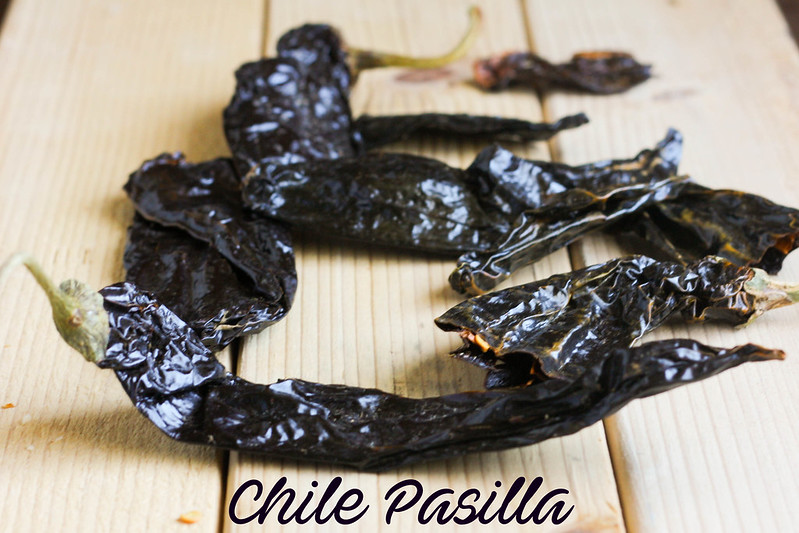 The other day, as I looked at the colorful dried chiles in their glass jars all lined up in a row in my cupboard, I realized that I had not posted a chile analysis in a while. As I’ve mentioned here before, it really wasn’t until I started working with dried chiles that I truly understood the profound flavors of Mexican cuisine. Now, I feel compelled to demystify them so that others are more likely to use them.
The other day, as I looked at the colorful dried chiles in their glass jars all lined up in a row in my cupboard, I realized that I had not posted a chile analysis in a while. As I’ve mentioned here before, it really wasn’t until I started working with dried chiles that I truly understood the profound flavors of Mexican cuisine. Now, I feel compelled to demystify them so that others are more likely to use them.
As an artist, I appreciate the chile like paint on a palette. By itself, each chile has a unique color and flavor that is independently beautiful just like each color of the rainbow. However, when colors are combined and painted is layered, an artist has the ability to create beauty in a painting. I especially enjoy when an artist understands the use of darks and lights because such contrast brings depth and life to artwork. Chiles are the same way. When blended with other chiles, the cook can create new tastes. However, it is the great cook who understands that in addition to flavor, each chile has tone. Some chiles deliver fresh, punchy notes while others are smooth, dark, and mysterious and add background flavors.
The pasilla chile is that one that will add complexity and sophistication to your cooking. Not only is it dark in color, but it is also bewitching in tone. It has the ability to make a person stop and say, “Now what is that flavor?”
 Name: Chile Pasilla
Name: Chile Pasilla
AKA: Chile Negro, Pasilla Negro; In California, ancho and poblano chiles are sometimes mislabeled as pasillas. It is important to remember that chiles have regional names both in Mexico and the United States. For my recipes, I am always referring to the chiles I describe here.
Fresh Chile Name: When fresh, this chile is called the chilaca.
Description: The pasilla is a dark, purplish-black pepper that is long and skinny. In general, it is 6-8” (15-20 cm) long and 1-1.5” (2.5-4 cm) wide. Pasillas are normally used in two ways—they are rehydrated and ground to make sauces or they are flash-fried and cut into a crispy topping that can be sprinkled on soups and salads. When rehydrated and pureed, the pasilla paste while be a darkish brown color with red overtones.
Flavor and Heat: The chile pasilla has a deeper flavor with a kick of smooth, but mild heat. They add a beautiful deep undertone to any salsa or sauce. The heat of the pasilla is comparable to a poblano. They are considered to be a mild pepper and range from 1,000-2,000 Scovilles on the heat scale.
Substitutions: Chile Ancho, Chile Mulato, Chile Negro
Other Information: *If a recipe calls for a Oaxacan pasilla, it is referring to a different variety of chile. The chile pasilla de Oaxaca is used to make mole negro. It is usually a smoked chile pasilla. The word pasilla is derived from the word “pasa” which means raisin.
 One of favorite recipes that showcases the chile pasilla is Beef Barbacoa (pictured below) by Lola Wiarco Dweck from Lola’s Cocina. One taste of this stuff and you will be a dried chile convert. I promise.
One of favorite recipes that showcases the chile pasilla is Beef Barbacoa (pictured below) by Lola Wiarco Dweck from Lola’s Cocina. One taste of this stuff and you will be a dried chile convert. I promise.

I love your descriptions and especially love how you offer substitutes. I know each chile is unique, but in Colorado it’s not always easy to find all of the ones I like for my recipes so good substitutes are key!
You are so right! I think that’s how new dishes are born, too. We substitute ingredients for ones we can’t always find. When I was in Mexico, I remember wanting to make chocolate chip cookies for my English students. I couldn’t find brown sugar, so I decided to ground up piloncillo. The cookies turned out different than the ones I always make, but I loved them! They had these little pieces of piloncillo that would leave a little burst of sweetness in your mouth.
That happened to us too when we were trying to make chocolate chip cookies in Mexico!